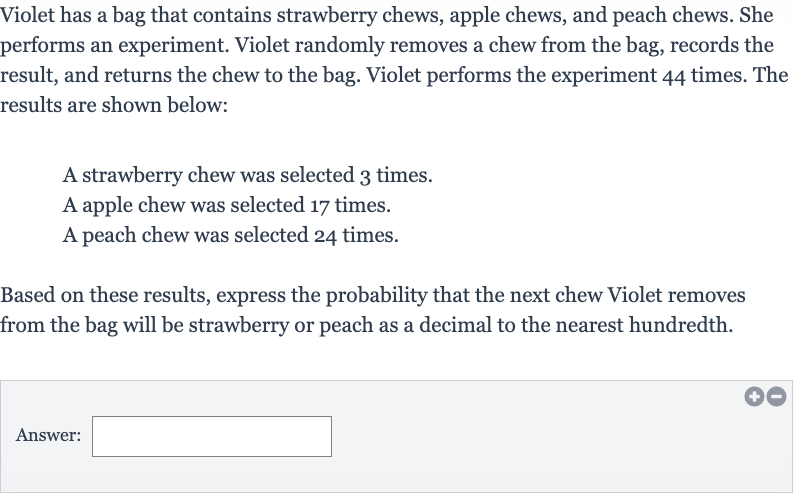AI tutor
Welcome to Bytelearn!
Let’s check out your problem:

Violet has a bag that contains strawberry chews, apple chews, and peach chews. She performs an experiment. Violet randomly removes a chew from the bag, records the result, and returns the chew to the bag. Violet performs the experiment times. The results are shown below:A strawberry chew was selected times.A apple chew was selected times.A peach chew was selected times.Based on these results, express the probability that the next chew Violet removes from the bag will be strawberry or peach as a decimal to the nearest hundredth.Answer:
Full solution
Q. Violet has a bag that contains strawberry chews, apple chews, and peach chews. She performs an experiment. Violet randomly removes a chew from the bag, records the result, and returns the chew to the bag. Violet performs the experiment times. The results are shown below:A strawberry chew was selected times.A apple chew was selected times.A peach chew was selected times.Based on these results, express the probability that the next chew Violet removes from the bag will be strawberry or peach as a decimal to the nearest hundredth.Answer:
- Calculate Total Selections: Determine the total number of times a strawberry or peach chew was selected. Strawberry chews were selected times, and peach chews were selected times. To find the total number of times either a strawberry or peach chew was selected, we add these two numbers together. (strawberry) + (peach) =
- Calculate Probability: Calculate the probability of selecting a strawberry or peach chew. The probability is the number of favorable outcomes divided by the total number of trials. We already know that the favorable outcomes (strawberry or peach chews) occurred times, and the total number of trials is . Probability (strawberry or peach) = Number of times strawberry or peach was selected / Total number of trials Probability (strawberry or peach) =
- Convert to Decimal: Convert the probability to a decimal.To convert the fraction to a decimal, we divide by .
- Round to Nearest Hundredth: Round the decimal to the nearest hundredth.To round to the nearest hundredth, we look at the third decimal place. Since the third decimal place is a , we do not round up the second decimal place. rounded to the nearest hundredth is .
More problems from Find probabilities using the binomial distribution
QuestionGet tutor help
QuestionGet tutor help
QuestionGet tutor help
QuestionGet tutor help
QuestionGet tutor help
QuestionGet tutor help
QuestionGet tutor help
QuestionGet tutor help
QuestionGet tutor help
QuestionGet tutor help
